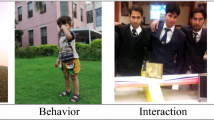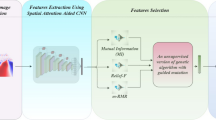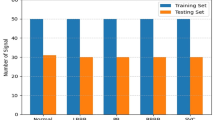Abstract
This paper proposes a novel computer vision approach that processes video sequences of people walking and then recognises those people by their gait. Human motion carries different information that can be analysed in various ways. The skeleton carries motion information about human joints, and the silhouette carries information about boundary motion of the human body. Moreover, binary and gray-level images contain different information about human movements. This work proposes to recover these different kinds of information to interpret the global motion of the human body based on four different segmented image models, using a fusion model to improve classification. Our proposed method considers the set of the segmented frames of each individual as a distinct class and each frame as an object of this class. The methodology applies background extraction using the Gaussian Mixture Model (GMM), a scale reduction based on the Wavelet Transform (WT) and feature extraction by Principal Component Analysis (PCA). We propose four new schemas for motion information capture: the Silhouette-Gray-Wavelet model (SGW) captures motion based on grey level variations; the Silhouette-Binary-Wavelet model (SBW) captures motion based on binary information; the Silhouette–Edge-Binary model (SEW) captures motion based on edge information and the Silhouette Skeleton Wavelet model (SSW) captures motion based on skeleton movement. The classification rates obtained separately from these four different models are then merged using a new proposed fusion technique. The results suggest excellent performance in terms of recognising people by their gait.










Similar content being viewed by others
References
BenAbdelkader C, Cutler R, Davis L (2002) Motion-based recognition of people in Eingenspace space. Proceedings of fifth IEEE International Conference on Automatic Face Gesture Recognition. doi:10.1109/AFGR.2002.1004165
Bobick AF, Davis JW (2001) The recognition of human movement using temporal templates. IEEE Transactions on Pattern Analysis and Machine Intelligence. doi:10.1109/34.910878
Boulgouris NV, Chi ZX (2007) Gait recognition using radon transform and linear discriminant analysis. IEEE Transactions on Image Processing. doi:10.1109/ICIP.2006.313058
Burrus S, Gopinath RA, Guo H (1998) Introduction to wavelets and wavelet transform. A Primer. Houston, Texas
Chellappa R, RoyChowdhury A, Sundaresan A (2003) A hidden Markov model based framework for recognition of human from gait sequences. IEEE International Conference Image Processing. doi:10.1109/ICIP.2003.1247165
Collins RT, Gross R, Shi J (2002) Silhouette-based human identification from body shape and gait. Proc Int’l Conf Automatic Face and Gesture Recognition. doi:10.1109/AFGR.2002.1004181
Data Base, CASIA Gait. www.sinobiometrics.com. Acessed 29 July 2010
Havasi L, Szlavik Z, Sziranyi T (2007) Detection of gait characteristics for scene registration in video surveillance system. IEEE Transactions on Imagem Processing. doi:10.1109/TIP.2006.888339
Hong L, Jain A, Pankanti S (1999) Can multibiometrics improve performance? Proc AutoID’99. http://www.cse.msu.edu/publications/tech/TR/. Acessed 29 July 2010
Hong S, Lee H, Nizami IF et al (2007) A new gait representation for human identification: mass vector. Second IEEE Conference on ICIEA Applications. doi:10.1109/ICIEA.2007.4318491
Kale A, Cuntor N, Yegnanarayana B et al (2003) Gait analysis for Human Identification. AVBPA. http://www.cfar.umd.edu/~kale/avbpa.pdf. Acessed 29 July 2010
KawTraKullPong P, Bowden R (2001) An improved adaptative background mixture model for real-time tracking with shadow detection. In In Proc. 2nd European Workshop on Advanced Video Based Surveillance. http://personal.ee.surrey.ac.uk/Personal/R.Bowden/. Acessed 29 July 2010
Lam L, Lee S-W, Suen CY (1992) Thinning methodologies—a comprehensive survey. IEEE Transactions on Pattern Analysis and Machine Intelligence. doi:10.1109/34.161346
Lee L, Grimson WEL (2002) Gait analysis for recognition and classification. IEEE Conference on Face and Gesture Recognition. doi:10.1109/AFGR.2002.1004148
Library, Open Source Computer Vision. http://opencvlibrary.sourceforge.net. Acessed 29 July 2010
Liu Z, Sarkar S (2006) Improved gait recognition by gait dynamics normalization. IEEE Transactions on Pattern Analysis and machine Intelligence. doi:10.1109/ICBBE.2007.142
Liu J, Zheng N (2007) Gait history image: a novel temporal template fo gait recognition. IEEE International Conference on Multimedia and Expo. doi:10.1109/ICME.2007.4284737
Murase H, Sakai R (1996) Moving object recognition in eingenspace recognition. Gait analysis and lip reading. Pattern Recognition Letters. doi:10.1016/0167-8655(95)00109-3
Niyogi SA, Adelson EH (1994) Analysing and recognizing walking figures in XYT. Proceedings CVPR. doi:10.1109/CVPR.1994.323868
Philips PJ, Moon H, Rizvi SA et al (2000) The FERET evaluation methodology for face-recognition. IEEE Transactions on Pattern Analysis and Machine Intelligence. doi:10.1109/34.879790
Phillips PJ, Sarkar S, Robledo I et al (2002) Baseline results for challenge problem of human id using gait analysis. Proc IEEE International Conference on Automatic Face and Gesture Recognition. doi:10.1109/AFGR.2002.1004145
Sarkar S, Phillips PJ, Liu Z et al (2005) The human Id gait challenge problem: data sets. Performance and analysis. IEEE Transactions on Pattern Analysis and Machine Intelligence. doi:10.1109/TPAMI.2005.39
Staufer C, Grimson WEL (1999) Adaptive background mixture models for real time tracking. IEEE Computer Society Conf on Computer Vision and Pattern Recognition. doi:10.1109/CVPR.1999.784637
Turk MA, Pentland AP (1991) Face recognition using eigenfaces. IEEE Computer Society Conference on CVPR’91. doi:10.1109/CVPR.1991.139758
Wang L, Tan T, Ning H, Hu W (2003) Silhouette analysis-based gait recognition for human identification. IEEE Transactions on Pattern Analysis and Machine Intelligence. doi:10.1109/TPAMI.2003.1251144
Winter D (1991) The Biomechanics and Motor Control of Human Gait: Normal, Elderly and Pathlogical. Walterloo Press, USA
Yang J, Wu X, Peng Z (2006) Gait recognition based on difference motion slice. ICSP Proceedings. doi:10.1109/ICOSP.2006.345931
Acknowledgments
The authors would like to thank the São Paulo State Foundation for Supporting Research (FAPESP) for their financial support of this research.
Author information
Authors and Affiliations
Corresponding author
Rights and permissions
About this article
Cite this article
Arantes, M., Gonzaga, A. Human gait recognition using extraction and fusion of global motion features. Multimed Tools Appl 55, 655–675 (2011). https://doi.org/10.1007/s11042-010-0587-y
Published:
Issue Date:
DOI: https://doi.org/10.1007/s11042-010-0587-y




